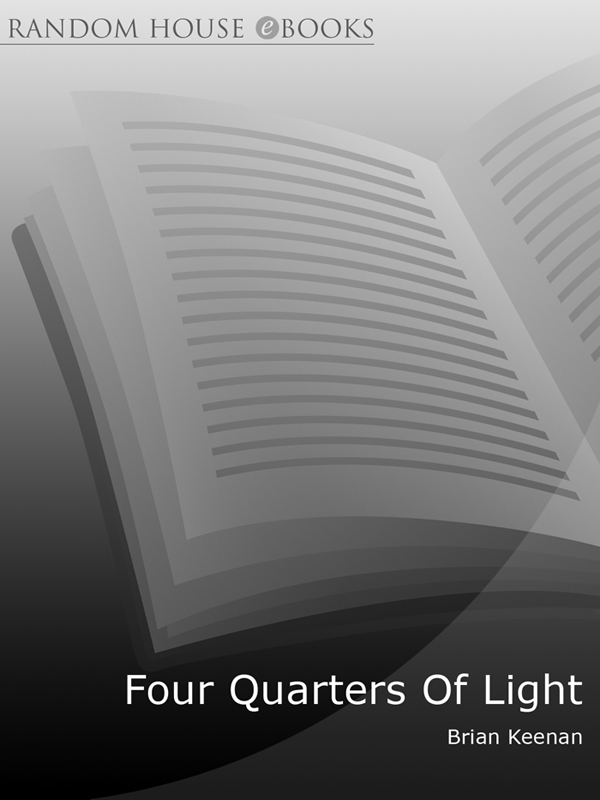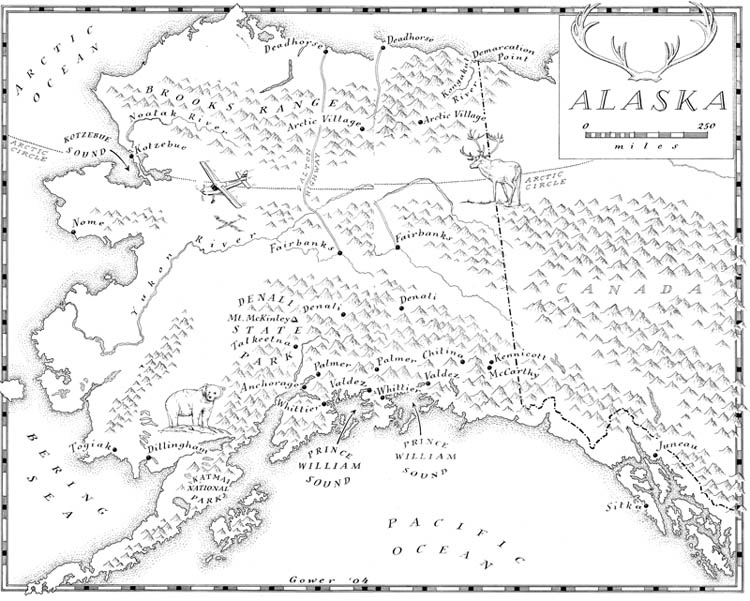Four Quarters of Light
Read Four Quarters of Light Online
Authors: Brian Keenan


OF LIGHT
A Journey through Alaska
Brian Keenan

This eBook is copyright material and must not be copied, reproduced, transferred, distributed, leased, licensed or publicly performed or used in any way except as specifically permitted in writing by the publishers, as allowed under the terms and conditions under which it was purchased or as strictly permitted by applicable copyright law. Any unauthorised distribution or use of this text may be a direct infringement of the author's and publisher's rights and those responsible may be liable in law accordingly.
Version 1.0
Epub ISBN 9781407068671
TRANSWORLD PUBLISHERS
61â63 Uxbridge Road, London W5 5SA
a division of The Random House Group Ltd
RANDOM HOUSE AUSTRALIA (PTY) LTD
20 Alfred Street, Milsons Point, Sydney,
New South Wales 2061, Australia
RANDOM HOUSE NEW ZEALAND LTD
18 Poland Road, Glenfield, Auckland 10, New Zealand
RANDOM HOUSE SOUTH AFRICA (PTY) LTD
Endulini, 5a Jubilee Road, Parktown 2193, South Africa
Published 2004 by Doubleday
a division of Transworld Publishers
Copyright © Brian Keenan 2004
Map by Neil Gower
The right of Brian Keenan to be identified as the author of this work has been asserted in accordance with sections 77 and 78 of the Copyright, Designs and Patents Act 1988.
A catalogue record for this book is available from the British Library. ISBN 0385 603061
All rights reserved. No part of this publication may be reproduced, stored in a retrieval system, or transmitted in any form or by any means, electronic, mechanical, photocopying, recording, or otherwise, without the prior permission of the publishers.
Typeset in 12/14 pt Goudy by Falcon Oast Graphic Art
Printed and bound in Great Britain by Clays Ltd, St Ives plc
1 3 5 7 9 10 8 6 4 2
Papers used by Transworld Publishers are natural, recyclable products made from wood grown in sustainable forests. The manufacturing processes conform to the environmental regulations of the country of origin.
1 Instructions and Preparations
2 First Footfalls in Fairbanks
7 Close Encounters of a Bear Kind
12 Churchers, Birchers and Searchers
20 More Mammoths and Musicians
For Audrey, Jack and Cal, crew of the RV
Pequod
.
For Debra, who guides me still.
And for Lena, who is alone now.
Also by Brian Keenan
An Evil Cradling
Between Extremes
(with John McCarthy)
Turlough
(novel)
Â
Brian Keenan
is a writer and poet.
An Evil Cradling
, the story of his four years' captivity in Beirut, is recognized as a non-fiction classic. He is also the author of a travel book,
Between Extremes
, with John McCarthy, and a novel,
Turlough
.
âThere is an ecstasy that marks the summit of life, and beyond which life cannot rise.'
Jack London
âHow great are the advantages of solitude! How sublime is the silence of Nature's ever-active energies! There is something in the very nature of wilderness, which charms the ear and soothes the spirit of man. There is religion in it.'
Estwick Evans, 1818
⢠Noeleen Gernon, who typed this manuscript while setting out on a new life journey herself.
⢠Pat Walsh in Fairbanks, Alaska, who worked out the logistics of my trip and introduced me to many people, a special friend to Audrey and the boys. Pat Walsh can be contacted for travel arrangements in Alaska at [email protected]
⢠Debra Chesnut, my guide into the Arctic and into myself.
⢠Mike Davis, âthe old man of the sea', who finally discovered what life is about and, like the salmon, came back! Congratulations.
⢠Eileen Monaghan and family, who anchored us in Anchorage.
⢠Clare and Tom Connolly and Noreen and Tom (the fireman), who entertained us in Anchorage.
⢠The Gwich'in people of Arctic Village.
⢠Lena and Charlie Mendenhall.
⢠Mike Murphy and family, Mike McCarthy and Laura, Mary Shields, John Reese, Jane Haig and John Luther Adams â Alaskans all, and all of whom enriched my journey.
⢠My editors, Bill Scott-Kerr and Heather Barrett, who waited until the whale came home.
⢠And finally my wife Audrey and my sons Jack and Cal, the other anchors in my life, who never let me get lost.

 Instructions and Preparations
Instructions and PreparationsFrom where I sit at my study window in Co. Dublin, I can see the rolling swell of the Wicklow hills. On stormy nights, if I walk to the end of the short terrace of which my house is the last but two, I can hear the sea's turbulence. As I look at the quaintly named Sugar Loaf mountain, I think that such a hill would not register in the landscape of the far Alaskan Northland. In a panorama that has one's head turning in a hypnotic 360-degree movement, in a mountainscape of fantastic dimensions such as you would only imagine in the illustrations of a mythic saga, such a pathetic headland would not even merit a nod.
Horizons are neither fixed nor finished in the Northland. Any horizon that presents itself to you only marks the limit of your vision; far beyond what you see, you know there is more. Another rugged mountain range, another somewhere, probably nameless and likely uninhabited. Only migratory birds, in their hundreds of thousands, know this landscape intimately. We poor land-bound, sight-blighted creatures can only grasp at things with our imagination and stumble over words such as permafrost, tundra and boreal forest, hot springs and pack ice, aurora borealis and midnight sun. They are all phenomena particular to the far north, but
to me they are more than that: they are magic words, like a fistful of polished bone thrown from some shaman's hand. In them you might discover more of yourself than you know. Perhaps that's why I went to the final frontier â for the magic, before my own bones were too feeble for the task.
But an old man's romance is not enough for an answer; in any case, romance belongs to the rocking chair and recollection. We go places for our own reasons, even if we only half understand them. On the closing page of
Between Extremes
, an account of my travels in Patagonia and Chile co-authored with John McCarthy, I wrote, âI sensed that the only important journey I would make henceforth would be journeys out of time and into mind. There was another landscape to be discovered and negotiated. The landscape of the heart, the emotions, and the imagination had to be opened up and new route maps plotted . . . We talked late into the night arguing whether or not we, too, have journeys mapped on our central nervous systems. It seemed the only way to account for our insane restlessness.'
So how could I now account for my own restlessness and my insistence on travelling to Alaska? It seemed to stand in contradiction to my deeply felt resolve at the conclusion of my South American travels. If I had determined that the only journeys I would make should be into the imagination and the landscape of the heart, then why was I thinking again of the Alaskan wilderness? For it was more than an old man's romantic folly, if not best forgotten then consigned to wishful thinking. The idea of an undiscovered country set in an elemental landscape fascinated me. It appealed to my anarchistic notions of boundless freedom. Sure it was romantic, but it was also real. Alaska was not a figment of my imagination. It existed in time and in place, and in my mind as somewhere that might test my self-assurance. One thing was for sure: it was clearly written on the map of my central nervous system.
It's a long way from Avoniel Road, where I went to school, to Alaska, where I dreamed of going, and the distance is in more
than miles and physical geography. After all, what correspondence could there be between Belfast in the north of Ireland and Barrow in the far north of the Arctic Circle? But Avoniel primary school in east Belfast gouges itself up out of my memory as an original point of departure. It was 1959, and I was approaching my tenth birthday. I was a âgood child', as my mother described me, quiet and untroublesome.
The school was a big, two-storey barracks of a building, solid and imposing, set among the maze of back streets it served. A great lawn of two junior-sized football pitches stretched out in front of it. To the right and screened from the entrance was a concrete netball pitch, and beside that the boys' and girls' outside toilets. Whatever advantage the 1947 Education Act had provided for the children of the area it did not accommodate indoor plumbing. But then this was the catchment area of the aircraft factory and the shipyard, and me and my mates were all cannon fodder for the engineering industry. The football pitches were the largest green space in the area but they were forbidden to any of us after school hours. I was not of an athletic disposition anyway, and though I occasionally scaled the railings during the summer holidays it was more because the place was forbidden than out of any desire to kick a football.
I compensated for my lack of sporting skills by finding a refuge in books. I excelled at reading and had finished all the âreaders' we were required to make our way through long before my peers. If I was always the last kid picked to play, I was equally the first to complete any reading tasks, and I had more gold stars than anyone in my class. My special reward for being so far in advance of the rest of my classmates happened the day my teacher called me aside and suggested I might like to choose a book from the library. The library in Avoniel was an old Welsh dresser with locked doors stationed at the end of the first-floor corridor. It was also where the classrooms for the kids about to go to the âBig' school were located, and the library was exclusively for their use. The upper shelves were full with about three dozen books. I remember being quite frightened as my teacher walked me out of the class,
admonishing the rest of the kids to be quiet and get on with their work until we returned. Whatever alienation I had felt from the rest of my mates, it was now compounded by this âhonour'. I was nine at the time and should not have been using the library for another year or two.
